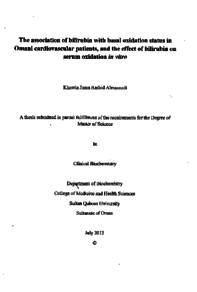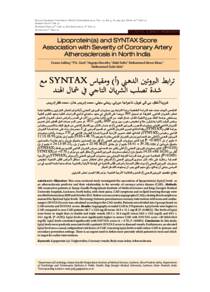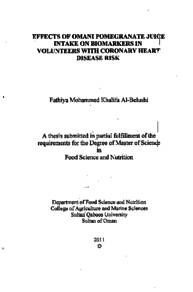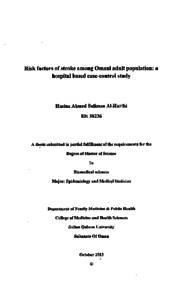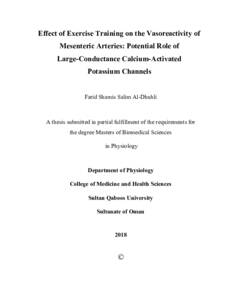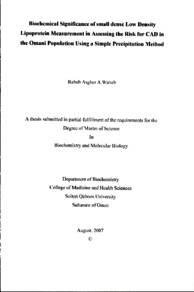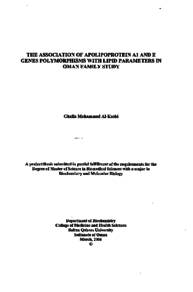وثيقة
The association of bilirubin with basal oxidation status in Omani cardiovascular patients, and the effect of bilirubin on serum oxidation in vitro
الناشر
Sultan Qaboos University
ميلادي
2013
اللغة
الأنجليزية
الملخص الإنجليزي
Background: Atherosclerosis is an inflammatory disease of the arterial wall which is the major cause of cardiovascular disease worldwide. The disease involves the formation of plaques in arterial walls restricting blood flow and increasing the risk of myocardial infarction. It is now believed that atherosclerosis represents a state of increased oxidative stress mainly characterized by lipid oxidation in the vascular wall. Atherosclerosis is mainly initiated by an accumulation and subsequent oxidation of low density lipoprotein (LDL) particles in the arterial Intima which is triggered by circulating free radicals. Lipid peroxidation plays a major role in the development of atherosclerosis. However, the oxidation damage caused by free radicals can be minimized by many antioxidants. Recently bilirubin was highlighted to have antioxidant effects in vitro and in vivo, The lipoprotein oxidizability is usually studied by the isolation of single lipoprotein (LDL) fractions, which is a tedious time-consuming process which renders it unuseful for clinical routine practice. Recently limited reports showed that the use of unfractionated serum may be of similar value.
Aims: This project had four main aims: 1) unfractionated serum was tested for its possible use to study serum oxidizability in vitro by formation of a typical oxidation curve consisting of the following components: basal oxidation status value (BOS), lag phase, propagation phase and saturation phase. 2) The antioxidant effect of different concentrations of commercial bilirubin was investigated on the components of the serum oxidation curve. 3) Bilirubin levels were measured in patients with acute coronary syndrome and controls, and its correlation with BOS and metabolic syndrome components was investigated. 4) In addition, we attempted to downsize the routine cuvette procedure, by which only a limited number of samples could be tested for serum oxidation status, to a plate method involving 96 samples and less sample in one run, in an effort to maximize the ability to test samples routinely for basal serum oxidation status.
Materials and Methods: 24uL of serum was added to a solution of PBS containing 100uM copper (total volume of the reaction mixture is 1.2 ml) in a standard quartz cuvette. The formation of a typical lipid oxidation curve was monitored by spectrophotometry at 245 nm using a standard UV- spectrophotometer. Secondly, the copper induced serum oxidation was measured spectophotometrically at 245 nm in the presence of different bilirubin concentrations (2-128uM) to test for the antioxidant effect of bilirubin. Thirdly, serum total bilirubin in acute coronary syndrome patients and controls was quantitated by using cobas 11 lanalyzer (Roche Diagnostics). Also BOS for the same samples were measured spectrophotometry after copper induced oxidation. Fourthly, the procedure was downsized by using a 96 well quartz plate, were only 3ul of serum sample and 150ul of copper reagent was used and the plate was measured spectrophotometry at 245 nm in one run in a plate reader machine. SPSS 10 package was used for statistical analysis.
Results and-Discussion: A typical lipid oxidation curve was obtained using copper as an -oxidizing agent..on unfractionated serumandbilirubin was shown to significantly inhibit
serum oxidation with increasing concentrations. Bilirubin levels were significantly decreased in ACS patients compared to the controls, but no significant correlation was found between bilirubin levels and.BOS in the patients or controls. Importantly bowever, increased bilirubin . : levels correlated positively with LDL size, consistent with the less atherogenic profile of the controls as larger LDL particles are less atherogenic than in the patients, and correlated negatively with ApoB, a proposed cardiovascular risk factor, findings that are consistent with bilirubin's role as an antioxidant. On the other hand, BOS was higher in ACS patients and showed a negative correlation with LDL size, HDL-C, ApoAl and a positive association with the rest of the parameters of metabolic syndrome which is consistent with an atherogenic profile of the patients. Multiple linear regression analysis revealed that serum triglycerides were the main independent predictors of BOS in the patients reflecting that increased TG levels is a major determinant of basal oxidation status . Interestingly also, there was a significant positive association of BOS with liver enzymes, particularly GGT which is an established serum oxidant linked to cardiovascular disease. Finally, results obtained by the modified plate procedure for measuring BOS showed results comparable to the standard cuvette method; findings that indicate promising use of this method in routine clinical practice, however, further modifications and standardization of the new technique are required.
المجموعة
URL المصدر
الملخص العربي
تصلب الشرايين هو التهاب جدار الشرايين. وهو السبب الرئيسي لأمراض القلب والأوعية الدموية في جميع أنحاء العالم. ينطوي هذا المرض على تشكل لويحات في جدران الشرايين مما يؤدي إلى تقييد تدفق الدم ويزيد من خطر احتشاء عضلة القلب. ويعتقد الآن أن تصلب الشرايين يمثل حالة من زيادة الأكسدة التي تنتج أساسا بسبب أكسدة الدهون في جدار الأوعية الدموية. يبدأ تصلب الشرايين بتراكم وأكسدة (sdLDL ) في بطانة الشرايين والتي يتم بسبب العوامل المؤكسدة Free Radicals. اكسدة الدهون تلعب دورا رئيسيا في تطور تصلب الشرايين، ومع ذلك، فإن ضرر الأكسدة التي تسببها الجذور الحرة (Free Radicals) يمكن التقليل منه بواسطة العديد من المواد المضادة للاكسدة. مؤخرا تم تسليط الضوء على أن البيليروبين قد يكون له تأثير مضادة للأكسدة في المختبر وفالدم . عادة ما يتم دراسة اكسدة oxidizability الدهون في المختبر عن طريق فصل (LDL) وهي عملية تستغرق وقتا طويلا مما يجعلها صعبة الممارسة بطريقة روتينية في المختبر. مؤخرا أظهرت تقارير محدودة أن استخدام المصل غير المجزا Unfractionated serum قد يكون ذا قيمة مماثلة في دراسة اكسدة الدهون في المختبر. الأهداف: كان لهذا المشروع أربعة أهداف رئيسية وهي: 1) اختيار المصل غير المجزا unfractionated serum لدراسة الأكسدة oxidizability في المختبر عن طريق تشكيل منحنی أكسدة نمونجي يتكون من العناصر التالية: حالة الاكسده الاصلية (BOS)، مرحلة زيادة الأكسدة propagation phase ، ومرحلة التشبع saturation phase . 2) دراسة تأثير تراكيز مختلفة من البيليروبين المحضر في المختبر على مراحل منحني الأكسدة. 3) قياس مستويات البيليروبين في المرضى الذين يعانون من أمراض القلب Acute Coronary) (Syndromeو التحقق من وجود أي علاقة بين البيليروبين و BOS في دم هؤلاء المرضى ومكونات متلازمة الأيض. 4) وبالإضافة إلى ذلك، حاولنا انشاء تقنية جديدة لدراسة عملية اكسدة المصل فالمختبر والتي تتميز باستخدام عدد اكبر من العينات في وقت زمني قصير، تتمثل هذه التقنية باستخدام لوحة well-96 ، في محاولة لتحقيق أقصى قدر من القدرة على اختبار العينات بشكل روتيني لدراسة حالة الأكسدة في مصل الدم. تم اضافة النحاس كعامل مؤكسد بالتركيز التالي (HM100) لعينة المصل (الحجم الكلي للخليط التفاعلي في Cuyetteهو 1. 2 مل)، وتمت مراقبة تشكل منحنى الأكسدة بواسطة القياس الطيفي في 245 نانومتر باستخدام معيار الأشعة فوق البنفسجية. ثانيا، تم قياس تأثير تراكيز البيليروبين-2) (Mر 128 على أكسدة المصل spectoplotometrically في 245 نانومتر. ثالثا، تم قياس البيليروبين باستخدام جهاز Cobas111 ، أيضا تم قياس BOS لنفس العينات باستخدام النجاس كعامل مؤكسد. رابعا، تم تخفيض حجم عينة المصل إلى 3 ميكرولتر وحجم المحلول المؤكسد (النحاس) الى 150 ميكرولترا في كل بتر من لوحة 96 ، وتم القياس الطيفي في 245 نانومتر بواسطة جهاز قاري اللوحة. تم استخدام 10 SPSS للتحليل الإحصائي. تم الحصول على منحنى نموذجي من اكسدة المصل. باستخدام النحاس بالاضافة الى ملاحظة تاثير تراكيز البيليروبين المختلفة على اكسدة المصل. : النتائج والمناقشة: وقد انخفضت مستويات البيليروبين بشكل ملحوظ في مرضى القلب مقارنة مع الضوابط (controls )، ولكن لا يوجد ارتباط كبير بين مستويات البيليروبين وBOS في المرضى او الضوابط (controls ). لكن الأهم، هو أن مستويات البيليروبين تتناسب طرديا مع حجم LDL، وهذا يتفق مع أن الضوابط لديهم مستوى البيليروبين اعلى من المرضى الذين يعانون من انخفاض مستويات البيليروبين وصغر حجم جزينات LDL ، وعكسيا مع ApoB، وهو من العوامل الخطره على القلب والأوعية الدموية، وهذه النتائج تنسجم مع دور البيليروبين كمضاد للتاكسد. من ناحية أخرى، كان BOS أعلى في مرضى القلب وأظهرت وجود علاقة سلبية مع حجم ApoA1 ، HDL - C ، LDL مع وجود علاقة إيجابية مع بقية عوامل متلازمة الأيض وهو ما يتسق مع عوامل تصلب الشرايين من المرضى. كشف متعددة تحليل الانحدار الخطي أن مستويات الدهون الثلاثية (TG) هم المسببات الرئيسية المستقلة ل BOS في المرضى مما يعني أن زيادة مستويات TG هو أحد المحددات الرئيسية لحالة الأكسدة في الدم. ومن المثير للاهتمام أيضا، كان هناك وجود علاقة إيجابية هامة بين BOS مع إنزيمات الكبد، وخاصة GGT وهو إنزيم مؤكسد في المصل يرتبط بأمراض القلب والأوعية الدموية. وأخيرا، أظهرت النتائج التي تم الحصول عليها بواسطة لوحة well-96 لقياس BOS نتائج مماثلة لطريقة curvette القياسية، والنتائج التي تشير إلى استخدام هذه الطريقة واعدة في الممارسة السريرية الروتينية، ومع ذلك، تحتاج إلى مزيد من التعديلات وتوحيد التقنية الجديدة.
قالب العنصر
الرسائل والأطروحات الجامعية

